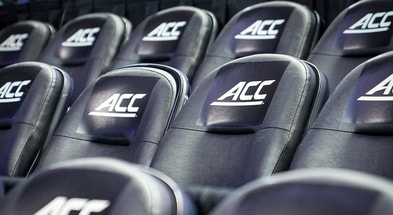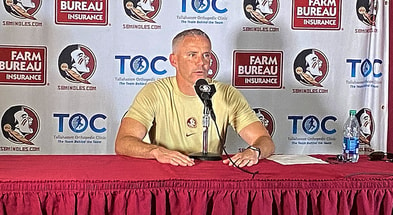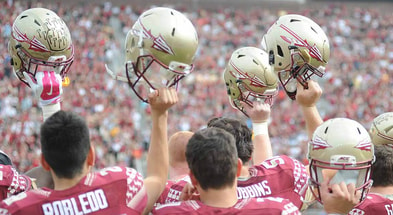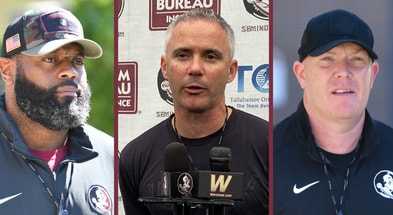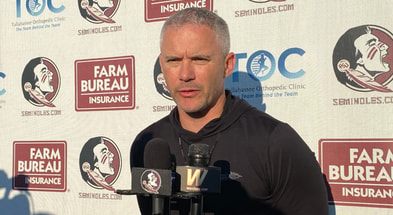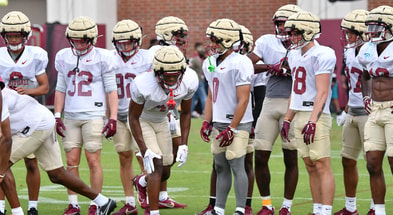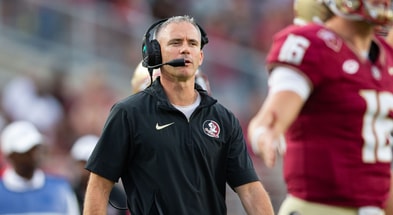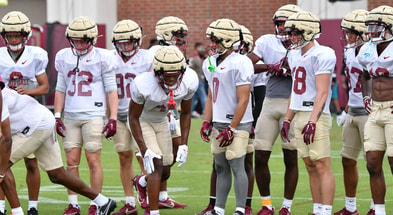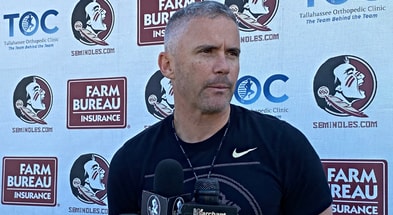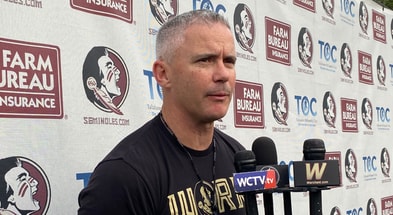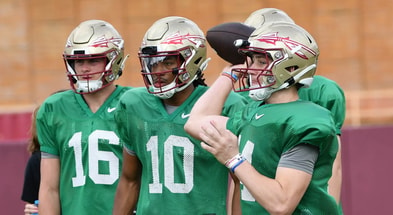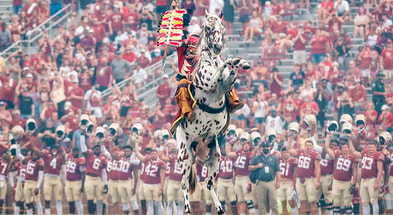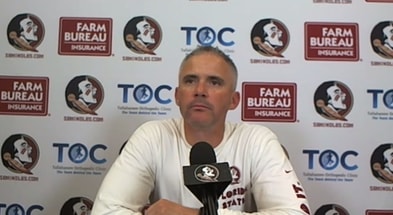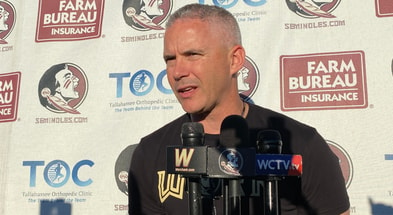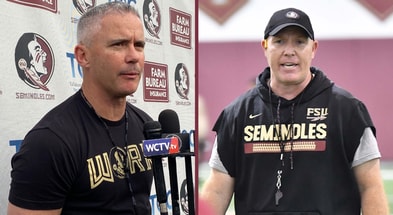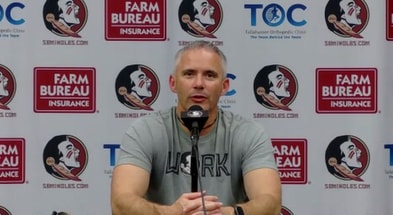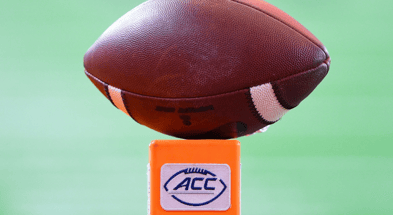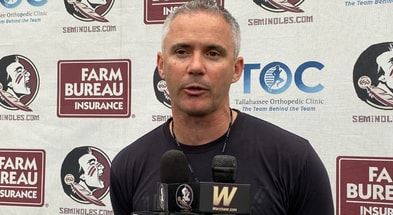Ira Schoffel: Florida State is ready to lead charge, but who will go along? And to what lengths?
AMELIA ISLAND — There are no roller coasters or amusement parks in this particular Sunshine State vacation destination, but it might have felt that way for fans of ACC schools monitoring this week’s conference spring meetings.
First, there were reports Monday that seven ACC schools, led by Florida State and Clemson, have been meeting in private to discuss the future and viability of the conference. Then there were Internet rumors of other schools jumping on board as well, which apparently had some fans and media thinking there might be news of a big exodus right here this week.
Then, Florida State athletics director Michael Alford, who has been the squeakiest of the ACC’s squeaky wheels, met with the media on Tuesday and seemed to downplay the concerns he expressed earlier this year and again to Warchant last week about the conference’s ability to remain competitive with the Big Ten and SEC.
Alford said on Tuesday he was pleased that the ACC is opening the door to uneven revenue distribution, which could lead to larger payouts to schools such as Florida State and Clemson, and that he was “optimistic” about the league’s ability to remain competitive nationally.
Finally on Wednesday, ACC Commissioner Jim Phillips concluded the meetings by saying he has been assured by all 15 of the member schools — “emphatically” — that they are committed to helping the conference find solutions to its problems. He even said the fact that league schools have been sending lawyers to the conference’s headquarters to evaluate the ACC’s various contracts is not a “warning sign” to him that the league is in trouble.
“What I’ve been told is that we’re all in this thing together,” he said.
While that all sounds well and good — and led to plenty of positive headlines about the stability of the conference — the harsh reality is that nothing substantial changed here this week when it comes to the concerns of those seven (or maybe eight or nine) schools.
They are every bit as worried about their futures in this league as they were before they arrived on Monday afternoon.
So why did Alford say what he said on Tuesday? Well, it’s important to remember that two things can be true at the same time: Alford could be pleased that the ACC is at least experimenting with uneven revenue distribution, while still also being extremely concerned about the Seminoles’ chances to compete nationally given the conference’s massive revenue gap.
How could he not be concerned about that? How could any of these schools?
The gap is real. And daunting.
But before we get too worked up over what might or might not happen in the future — and whether an exodus from the ACC is imminent — let’s take stock of what we do and do not know.
Is it accurate to say seven or eight schools in the conference are like-minded in the push for additional revenue from the ACC and are interested in exploring whatever options might be available if that doesn’t happen? Absolutely. That is no longer based on unnamed sources; it was confirmed by multiple ACC athletics directors this week.
Is it also accurate to say that group is completely unified in what they’re willing to do to make that happen? Or that they’re all on board with breaking free into the great wide open if nothing improves soon? Probably not yet. At least as far as I can tell.
That could certainly change in the future — maybe even in the near future. But I don’t believe they are quite there yet.
What I am 100 percent confident about is that the two schools leading this charge — Florida State and Clemson — are willing to do whatever it takes to stay competitive in college football and other sports.
Of that I have no doubt. Miami might be in that boat, too.
I believe the leadership of those schools have looked at the college sports landscape — a landscape that soon will feature rivals in the Southeastern Conference and Big Ten each receiving $30 million to $40 million per year more than schools in the ACC — and have come to the conclusion that they won’t be able to compete for championships if things remain the same.
Not just in football. But in sports across the board.
Some of that extra SEC and Big Ten money undoubtedly will be used to hire the best coaches and build the best facilities in men’s and women’s basketball, baseball and softball, and everything else they choose. Which could be, well, everything.
And it eventually will — if it hasn’t already — make its way to NIL opportunities for players, as schools direct donors to give money to collectives instead of contributing to facilities and operating budgets.
It was one thing when ACC schools received around $5 million or $10 million less per year than their rivals. Florida State and others felt they could contend with that. But $30 million or $40 million? Every year? Through 2036?
That’s not an option for Florida State. And probably not for Clemson, Miami and some others.
But what are the options?
Well, that likely depends on how far these eight schools are willing to go. And how many are willing to go far enough.
Theoretically speaking, if there really was a rock-solid group of eight schools willing to threaten to dissolve the ACC and either join new conferences or start their own, that could be an extremely powerful force. They would possess a tremendous amount of leverage, and there’s a school of thought that they could make the ACC’s long-term Grant of Rights become a non-factor … or at least much less of a factor.
If that all happened, those eight schools could potentially then look to start their own conference and negotiate their own new television contract. Or see if the Big Ten, SEC and/or Big 12 have soft landing spots for them. Or simply threaten to do those things and get ESPN and the ACC to scrap the current Grant of Rights and give them more flexibility — and revenue — in the immediate future.
Leverage creates options. And options mean hope.
*** Sign up for premium access to Warchant.com and the On3 Network for only $29.99. ***
I’m sure all of these scenarios sound promising to fans of the schools who are considering taking that plunge. Especially when faced with the prospect of standing pat and ending up in a second- or third-tier conference.
But in the end, the fans and media won’t be making these decisions. It will be university presidents and boards of trustees. Included in that group will be academic-types, who aren’t typically fired up about taking major risks that could have massive consequences for their institutions.
While some of those school leaders are fully on board with joining Florida State, Clemson and Miami in pushing for more revenue, will they really be on board with going the distance? Will they sign off on busting loose if they don’t know exactly what happens next?
I’m not sure anyone knows that for certain. Nor do we know how quickly those decisions might be made.
Leaving the ACC would be an extremely bold endeavor, even for a school like Florida State, which is leading this charge and is likely the most willing to take these risks.
There’s a chance that all the schools wouldn’t find better homes. There’s a possibility that forming a new conference wouldn’t be as lucrative as they think. And that they wouldn’t get immediate access to the College Football Playoff, which would defeat the whole purpose.
There are a great many unanswered questions, including some they might not have even yet considered.
At the same time, it’s not as if staying put in the ACC is a decision free from risk. Particularly if nothing changes with the all-important TV revenue distribution (and there are no signs of that changing any time soon).
Is remaining in a conference where your financial resources are dwarfed by the competition not a risk?
Is being in a conference with a dwindling chance to win national championships not a risk?
The harsh reality of that scenario is perhaps most stark for the Florida State’s, Clemson’s and Miami’s because they have won football national championships in recent decades, and they want to win more.
It’s why a school like Florida State will force this issue and try to create as much leverage as possible. Why the Seminoles know they have no choice but to push and fight for every dollar they can.
Why I believe — and am completely confident in this — that Florida State would even go it alone if it had to. That if nothing changed with the ACC and other schools backed out, the Seminoles would write a check for the $120 million exit fee and wage the legal battle over the Grant of Rights, and see what they could get on the open market.
That’s not the course of action they want. That’s not the easiest — or perhaps even the smartest — approach. And I’m sure Michael Alford and his staff could come up with a lot better ways to spend $120 million.
But that’s how determined I think they are to avoid the status quo.
From talking to multiple Florida State sources, staying in the ACC — with a revenue gap of anything close to $30 million or $40 million each year — is a non-starter.
They would cut that check and run for the hills before sitting idly by while the rival Florida Gators stockpile an extra hundred million dollars of cash every few years. An extra $400 million or more by 2036.
What we don’t know — and I’m not sure even the leaders at FSU and its most aligned allies know — is who all would go with them.
Would it be the trio of the Seminoles, Clemson Tigers and Miami Hurricanes? Would North Carolina and Virginia join too? Would all eight or more?
It’s a daunting proposition, but desperate times call for desperate measures.
And in the end, these schools aren’t the only ones with serious decisions to make.
The ACC’s other six or seven universities, who so far seem unwilling to budge when it comes to redistributing the conference’s TV revenue, have some soul-searching to do as well.
If the future of the ACC looks bleak now, what would it look like if some — or all — of those other eight schools walked out the door?
Contact managing editor Ira Schoffel at [email protected] and follow @iraschoffel on Twitter.
Talk about this story with other die-hard FSU football fans on the Tribal Council.

